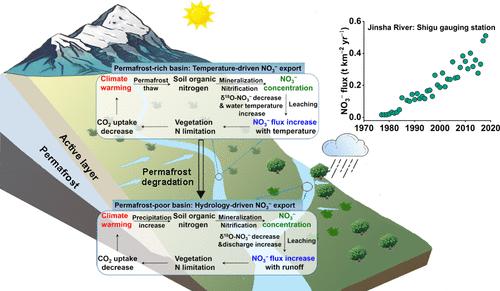气候变暖增加了高海拔河流的硝酸盐出口:不同流域的温度和水文控制
IF 11.3
1区 环境科学与生态学
Q1 ENGINEERING, ENVIRONMENTAL
引用次数: 0
摘要
高海拔流域河流硝酸盐(NO3 -)输出对气候变暖的响应尚不明确。在JSR,持续变暖已经推动了广泛的永久冻土融化,从1993年到2018年,NO3 -浓度和通量分别增加了~ 190 %和~ 220%。相比之下,长江三角洲NO3 -的输出主要受水文变异而不是温度的控制。土壤内硝化作用是河流NO3 -的主要来源,增温增强的硝化作用是NO3 -通量增加的主要驱动因素,径流则起次要作用。利用空间-时间替代方法,我们推断持续的冻土退化可能将NO3 -输出从变暖驱动转向水文驱动控制。这一转变预计将在升温和降水加剧的情况下增强氮淋滤,导致高海拔植被的氮限制和二氧化碳吸收减弱。这些发现揭示了以前未被充分认识的气候变暖的氮-碳反馈,对受永久冻土影响地区的地球系统模型具有影响。本文章由计算机程序翻译,如有差异,请以英文原文为准。

Climate Warming Increases Nitrate Export in High-Elevation Rivers: Divergent Temperature and Hydrological Controls across Basins
The response of fluvial nitrate (NO3–) export to climate warming remains poorly constrained in high-elevation basins. Here, we integrate multi-decadal NO3– flux records with multi-year measurements of NO3– concentrations and dual-isotope signatures (δ15N–NO3– and δ18O–NO3–) from two contrasting rivers on the Qinghai–Tibetan Plateau, the permafrost-rich Jinsha River (JSR) and the permafrost-scarce Yalong River (YLR), to evaluate climate-driven shifts in NO3– dynamics. In the JSR, where sustained warming has driven widespread permafrost thaw, NO3– concentrations and fluxes increased by ∼190 and ∼220%, respectively, from 1993 to 2018. In contrast, the NO3– export in the YLR was primarily controlled by hydrological variability rather than temperature. In-soil nitrification is the dominant source of fluvial NO3–, with warming-enhanced nitrification emerging as the primary driver of increased NO3– flux, while runoff plays a minor role. Using the space-for-time substitution method, we infer that ongoing permafrost degradation may shift NO3– export from warming-driven to hydrology-driven controls. This transition is expected to enhance nitrogen leaching under warming and intensified precipitation, contributing to nitrogen limitation in high-elevation vegetation and weakening of CO2 uptake. These findings reveal a previously underappreciated climate-warming nitrogen–carbon feedback with implications for Earth system models in permafrost-affected regions.
求助全文
通过发布文献求助,成功后即可免费获取论文全文。
去求助
来源期刊

环境科学与技术
环境科学-工程:环境
CiteScore
17.50
自引率
9.60%
发文量
12359
审稿时长
2.8 months
期刊介绍:
Environmental Science & Technology (ES&T) is a co-sponsored academic and technical magazine by the Hubei Provincial Environmental Protection Bureau and the Hubei Provincial Academy of Environmental Sciences.
Environmental Science & Technology (ES&T) holds the status of Chinese core journals, scientific papers source journals of China, Chinese Science Citation Database source journals, and Chinese Academic Journal Comprehensive Evaluation Database source journals. This publication focuses on the academic field of environmental protection, featuring articles related to environmental protection and technical advancements.
 求助内容:
求助内容: 应助结果提醒方式:
应助结果提醒方式:


